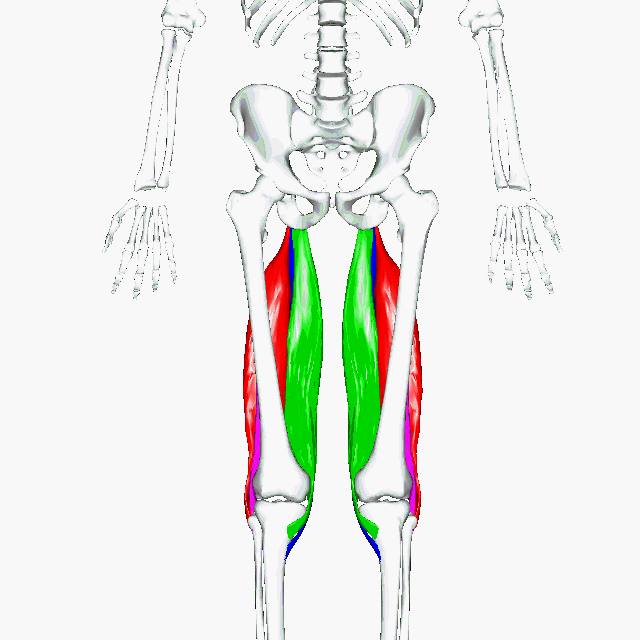A little anatomy knowledge can go a long way
I teach a lot of very smart people and yet, a lot of these people lack a basic understanding of how their bodies work.
Why? Because most of us weren’t taught this stuff.
Only a small amount of human anatomy and physiology is taught at school (in the UK at least); a little more is taught at upper secondary level if you opt to take a GCSE in PE, but — as someone who only really discovered that they could enjoy anything remotely sporty (let alone develop a ‘physical education’) until their mid-twenties — I certainly didn’t opt for one of those.
Anatomy can be a very dry topic with lots of complex and hard to remember names. But — having learned a lot about bodies and how they work — I also know that gaining knowledge about ourselves can go a long way, especially if it's relevant to who we are, the lives we lead, the activities we do, the ideas and beliefs we currently hold.
Knowing more about our body (the workings of its many muscles and joints, plus all the other amazing stuff it gets on with in the background) can help us make sense of how our body feels (and how we feel in our body).
If getting our nerd on wasn't reason enough, that knowledge can also save us time by helping us to make more informed choices about how we move.
Are your hamstrings a mystery?
It is very common for people to think about their hamstrings in terms of a feeling.
When I recently asked my class to define what the hamstrings were, their responses were general (both in sensation and in terms of location):
"That's easy. They're the things that hurt when I bend forward."
"They're the things at the top of the back of my thighs."
I would wager that every single yoga and movement teacher the world over has heard people talk more about their hamstrings than almost any other topic.
And yet, these words crop-up over and over again: tight, sore, stretch, more.
I think the hamstrings seem to feel like more of a problem because what they are and what they do remains a mystery to most people.
Get up close
BodyParts3D, © The Database Center for Life Science licensed under CC Attribution-Share Alike 2.1 Japan.
You have three hamstrings in each leg. It's super common for people to believe they have just one and that makes sense because the name doesn't give us a clue (unlike the 'quadriceps' that indicate 'four').
They are muscles. Maybe you think this is obvious, but it's really common for people to think of their hamstrings as tendons. (The 'string' part of the name is leftover from the ~15th century when people did think they were tendons).
They work with your quadriceps (the front of your thighs). These two groups of muscles form an 'antagonistic pair'. You can think of them as helpful movement 'opposites': as your quads contract, your hamstrings relax and vice versa.
The movements you make that your hamstrings are involved with…
Take a giant step, or make a big pedal action (from yoga for cyclists, lower body class).
The action of bending your knee (knee flexion) as you bring your leg upwards (hip flexion) involves the hamstrings relaxing (lengthening) as your quads contract (shorten).
The action of straightening your leg (knee extension) as you bring that leg downwards and/or backwards (hip extension) involves the hamstrings contracting (shortening) as your quads relax (lengthen).
Ok, that was a lot of words. So, the key takeaway?
Your hamstrings contract and relax – get shorter and longer – ALL THE TIME!
Get personal
Well, now you know that it is impossible to use your quadriceps (the 4 muscles at the front of each thigh) without using your hamstrings (the 3 muscles at the back of each thigh), and that your hamstrings do not stay at a fixed length, it might be appropriate to reconsider what you believe about your hamstrings.
Most people believe that their hamstrings feel tight because they are 'short'.
Most people intuit that the solution for tight hamstrings is stretching.
There is a big gap between what we feel and what is actually going on.
Take another look
Is this gap in knowledge a problem? Well, perhaps not. If your hamstrings cause you zero pain or issues, or you enjoy stretching (and maybe you're also a regular on the leg curl machine at the gym anyway), let's not create a problem for the sake of it.
But if it is a gap in knowledge, or inaccurate belief that motivates you to pursue inadequate solutions for long periods of time then, yes: yes, I do think that is a problem.
Don't you think it's weird that we think about stretching our hamstrings (probably) more than any other part of our body, yet rarely think about hamstring strength?
A normal hamstring to quadriceps strength ratio (H:Q) is considered to be between 50-80%. Without collecting specific data about ourselves, this ratio simply tells us that our hamstrings could do with being at least half as strong as our quads.
Perhaps you have zero interest in strengthening your hamstrings, but, if this basic anatomy lesson brought up some things for you like:
"Hmm, I wouldn't describe my hamstrings as strong, and stretching is too painful and doesn't seem to help very much..."
Then you might want to explore this a bit more.
Do you need to go to a gym, or attend a class to strengthen your hamstrings? No, of course not.
Start with your favourite search engine to find out more about these kinds of exercises and how you can progress them:
Hip hinge
Hamstring bridge
Learn more about your body





Starting from scratch, getting back into a routine, or wanting to try a new style of class? This beginner series is for you.




